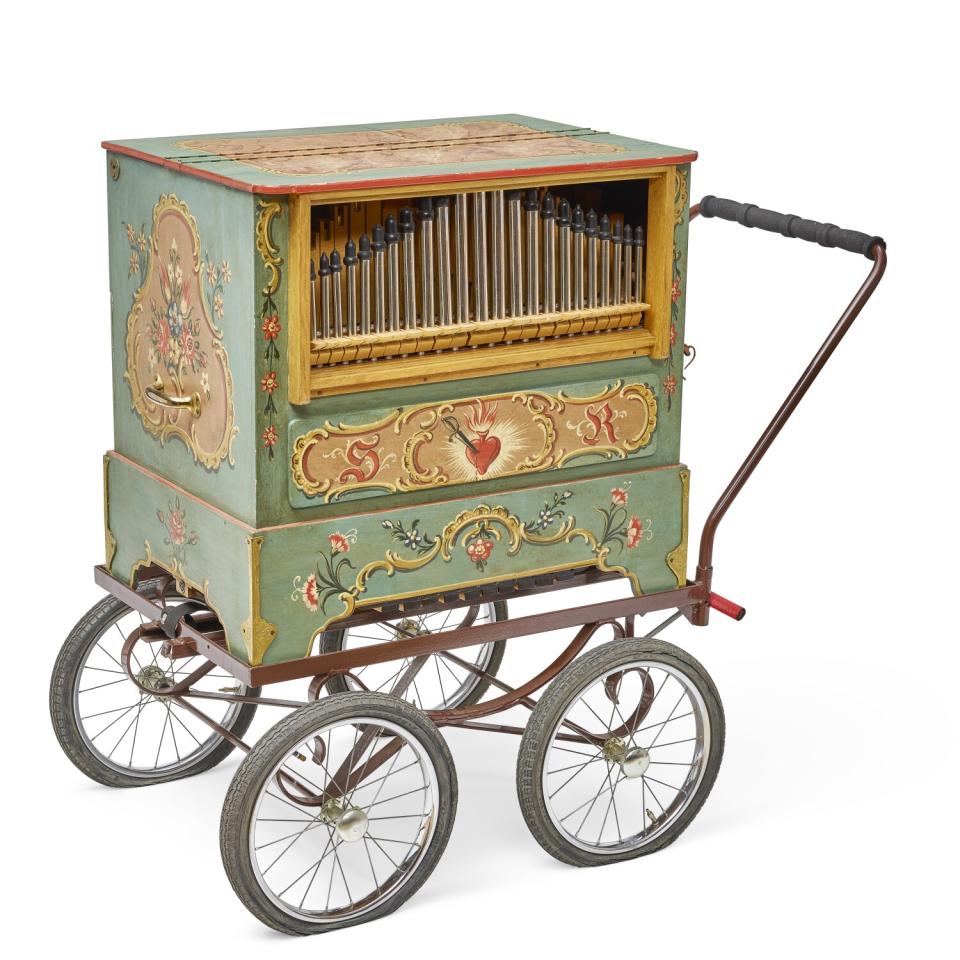Commentary: Barrel organs, bedazzled jackets: A guide to the Siegfried & Roy estate sale
- Oops!Something went wrong.Please try again later.

It’s not possible anymore to be famous and moneyed the way Siegfried & Roy were famous and moneyed. This is neither a good thing nor a bad thing, but it’s important to remember the cultural conditions that allowed two poor German immigrants — one a whiz with magic, the other having an uncanny connection with animals — to meet on a cruise ship, join talents and become the glitziest, campiest, longest-running act in Las Vegas history. The conditions were narrower, for one.
Whether you liked the act or not (alas, I never saw it), from their peak in the 1980s on, Siegfried Fischbacher — the blonder, more delicately featured one — and Roy Horn — tawny, brunet, with a bristle broom mustache that came and went — were actual icons. Their names were a byword for the very idea of Entertainment writ large. Their images were synonymous with big cats — the white tigers that were the cornerstone of their act. They worked and played and lived with the exotic animals for decades, making them disappear, levitate and so on while wearing complementary custom-made costumes dripping with sequins and beads, fanning out with shoulders and lapels out to God-knows-where.

The soap bubble of iridescent glamour popped suddenly in 2003 after Horn was attacked onstage by one of the tigers. The official story is that he suffered a minor stroke while performing, confusing the animal, which then tried to “help” Horn by dragging him offstage by the throat, like a cub.
After 30 years of sold-out, incident-free shows — part of the pair’s exclusive alliance with MGM the Mirage — sure, why not. Horn died in May 2020 of complications related to COVID-19. Fischbacher died just months later of pancreatic cancer. They were 75 and 81, respectively.
The duo’s estate, including personal items from their homes and wardrobes, is being auctioned this week at Bonhams. I previewed the sale with Helen Hall, the auction house’s director of popular culture, which is an incredible job. Here are some of their things.
Lot 223: A set of 12 Anglo-Indian shell inlaid wood dining chairs
The word “maximalist” would require new, extraneous and yet-to-be coined terms to describe the aesthetic Siegfried and & Roy projected. In reality, their personal tastes differed wildly. The two maintained separate homes on a 100-acre Nevada compound they called Little Bavaria. Roy lived in a cabin-style house filled with gothic furniture and European art. Siegfried’s was a sleek Midcentury Modern filled with glass, acrylic and ’80s things.
These chairs are from a third home on the property. For meetings. “There was also a house on the property that was just for Roy’s mother,” Hall says. The shell work is so pretty and delicate that it’s like sitting in a white camellia flower.

Lot 287: A barrel organ
I cannot stress this enough. Every girl needs an old-timey barrel organ. “There’s actually been a lot of interest in the organ,” Hall says. “We had to track down the manufacturer to find out what kind of battery it takes. Twelve volt. Easy to find.”
Lot 66: A possible Berlin Wall fragment
For all their tacky, accessible glamour, the guys knew that real luxury was about exclusivity. What’s harder to cop than a “possible” Berlin Wall fragment in an exclusive gray-with-a-shot-of-red colorway? “There’s language we have to use around the items for legal reasons,” Hall says. However, she adds with a smile, “We’re sure it’s authentic.”
Lot 348: A Cartier stainless steel and gold 'Tank Anglaise XL' wristwatch
There is a lot of jewelry in the sale. Much of it is customized with outsize jewels and images of big cats. This one is a testament to the duo’s playful attitudes toward taste. The Cartier “Tank” watch is what an underpaid copywriter might call a piece of understated luxury. The XL version is blown up to anything but understated proportions. In person, it looks like an oversize cartoon of a watch, which might cause the winning bidder to walk crooked, but I can’t imagine being able to pull this off without a sense of humor.
Lot 480: A pair of Western-themed jackets worn by Siegfried & Roy at the Stardust circa 1970s and the Frontier circa 1980s
These are giving off Isabel Marant vibes. Wear with jeans and flats. I think you could get away with it.
Lot 291: A group of nine Modern Creation München leather luggage pieces designed by Michael Cromer
There is a massive amount of luggage in the sale. Some is still tagged with humble laminated address labels held on by bits of yarn. Some is still in its original plastic wrap. All of it is from the flashy German luxury brand Modern Creation München, known by its acronym MCM. The signature logo-pattern perfect for Siegfried & Roy. Louis Vuitton or Goyard luggage would have been a bit too staid for the proudly new-money duo. The curators of the sale divvied up the lots to create several sets. This one ostensibly belonged to Siegfried and is the only one with a racket bag. Great for flexing at one of our many cracked and sun-bleached public tennis courts.
Lot 184: A Russian parcel gilt-metal mounted polychrome wood icon Mother of God
Siegfried & Roy were devout Catholics. “They had a little chapel in their home.” Hall says. “They were deeply religious. Siegfried’s sister was actually a nun.” Hall displays a photo from 1978 of Siegfried & Roy dressed in gold chains and dazzling white denim separates, affectionately flanking a young nun, Sister Dolore. There are several 19th century icons collected by Roy during his many buying trips across Europe, but I would recommend a signed photograph by Gandhi or Mother Teresa, which is also available.
Lot 125: An Indian painting of a tiger
The collection has paintings of tigers from across nearly every genre and art period, but this 9- by 9-foot fabric one from an unidentified artist is my favorite. The estimate tops out at $300. I might just bid on it myself.
The prices in general seemed surprisingly low. “We estimate everything according to its provenance and inherent value, not necessarily its owners,” Hall said. “Of course, when there’s an emotional connection, there’s an opportunity for things to sell much higher. But who knows? You might get a bargain.”
This story originally appeared in Los Angeles Times.

